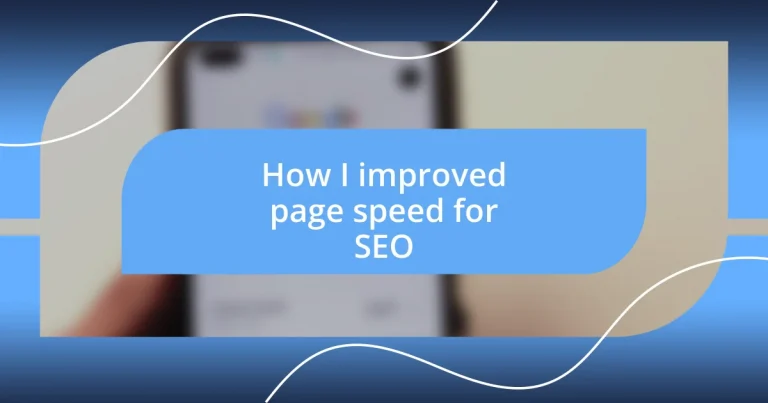Key takeaways:
- Page speed significantly impacts user experience and SEO rankings; optimizing it can lead to higher conversion rates and better visibility.
- Key metrics for assessing page speed include First Contentful Paint (FCP), Time to Interactive (TTI), Largest Contentful Paint (LCP), and Cumulative Layout Shift (CLS), which help improve user engagement and reliability.
- Continuous performance testing and optimizations using tools like Google PageSpeed Insights are essential for maintaining speed improvements and adapting to changes in the digital landscape.
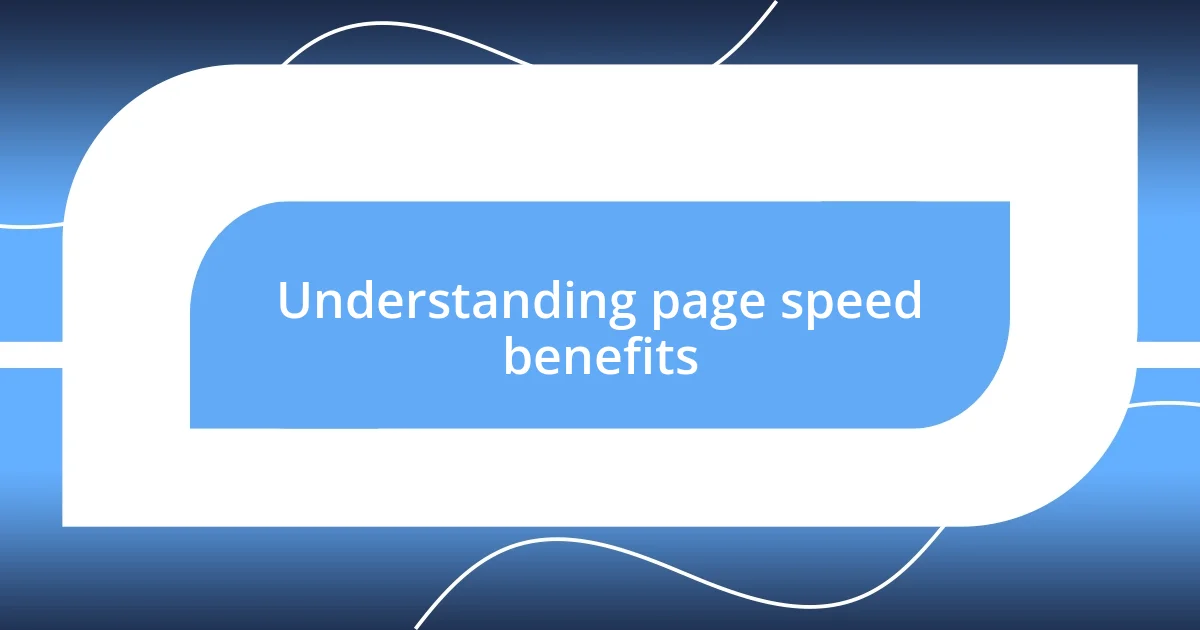
Understanding page speed benefits
Understanding page speed is crucial, as it directly affects user experience and SEO rankings. Think about those moments when you land on a slow-loading website; I know I often lose patience and click away, which could easily mean lost opportunities for a business. A seamless, speedy experience keeps visitors engaged, and that’s exactly what we want.
A faster page speed can lead to improved conversion rates. I remember when I optimized my site; I saw a tangible increase in users completing purchases. This wasn’t just about reducing load times; it was about creating an environment where customers felt confident browsing without frustration. Isn’t it fascinating how something as simple as speed can turn casual visitors into loyal customers?
Moreover, page speed is a critical ranking factor for search engines like Google. When I first learned this, it was an eye-opener. It meant that investing time in improving speed could make my website more visible to potential visitors. After all, who doesn’t want to stand out in the crowded online space? It’s a win-win situation—better speed for better rankings.
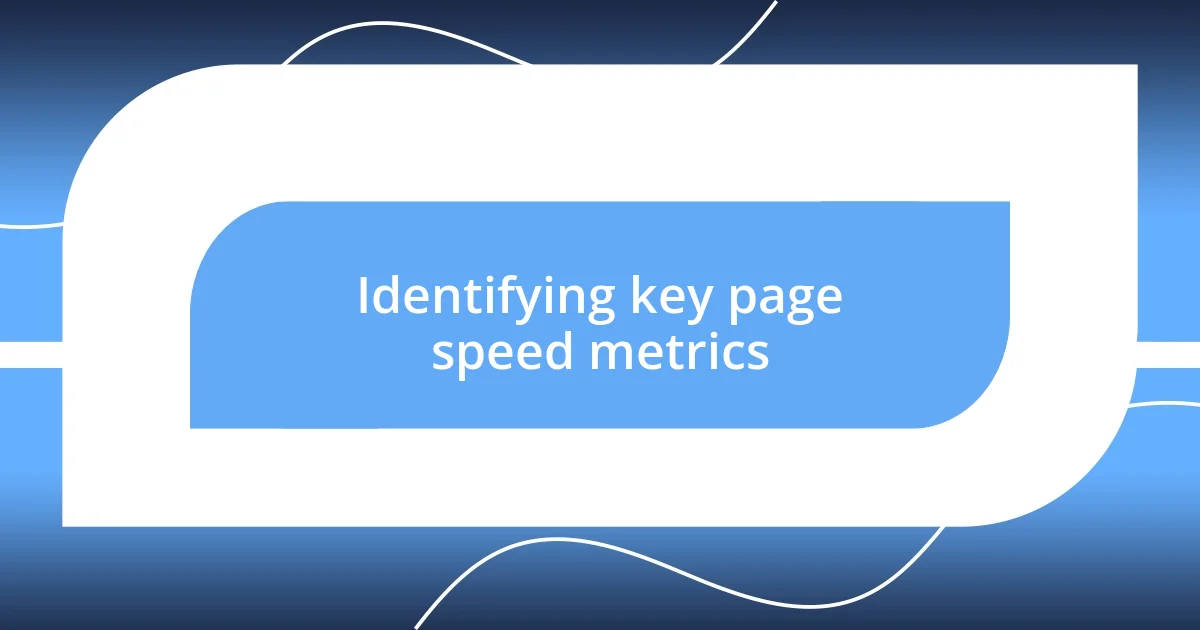
Identifying key page speed metrics
Identifying key page speed metrics is essential for understanding how your website performs. From my experience, two of the most critical metrics I focus on are First Contentful Paint (FCP) and Time to Interactive (TTI). FCP measures how quickly users can see the first piece of content, while TTI determines when the page becomes fully interactive. When I improved these metrics on my site, I noticed a significant drop in bounce rates and an uptick in user engagement.
Another pivotal metric is Largest Contentful Paint (LCP), which tracks when the largest visible content element on the page has loaded. I recall feeling a sense of accomplishment when I optimized elements to enhance my LCP; the perception of speed increased dramatically from visitors. When users saw content loading quickly, I could feel their excitement almost leap off the screen, which motivated me to continue improving site speed.
Lastly, measuring Cumulative Layout Shift (CLS) is crucial for assessing visual stability. I once encountered a situation where a layout shift startled me, causing me to click on the wrong button. This experience reinforced my belief in the importance of CLS—it’s more than just speed; it’s about creating a reliable experience where users feel secure navigating.
| Metric | Description |
|---|---|
| First Contentful Paint (FCP) | Time taken for the first piece of content to appear |
| Time to Interactive (TTI) | Time taken for the page to become fully interactive |
| Largest Contentful Paint (LCP) | Time taken for the largest content element to load |
| Cumulative Layout Shift (CLS) | Measures visual stability of the page |
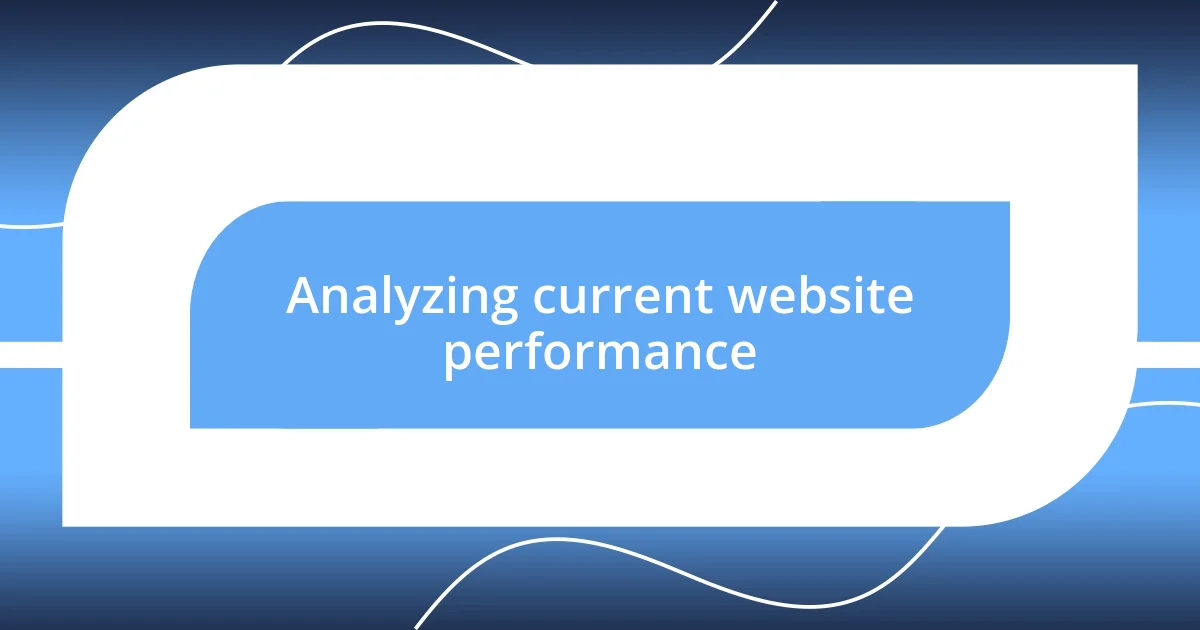
Analyzing current website performance
Analyzing your website’s current performance is a crucial step in optimizing page speed. When I set out to assess my own site, I used various tools like Google PageSpeed Insights and GTmetrix. Seeing the performance numbers made me realize how critical each second was—especially as I watched the loading timeframe tick away. It’s astounding how many potential customers you could be losing with even a slight delay.
Here are some key aspects to consider during your analysis:
- Load Time: Check how long it takes for your website to load completely. I remember feeling disheartened when I saw my site taking over five seconds; that was quite the wake-up call.
- Bounce Rate: Look at the percentage of visitors who leave after viewing only one page. When I observed a spike in my bounce rate, it pushed me to dig deeper into page speed issues.
- Device Responsiveness: Test your site’s performance on mobile and desktop. I was surprised to find that my mobile load times were significantly slower, which made me rethink my approach.
- Server Response Time: This metric often gets overlooked, but it can greatly impact user experience. When I optimized my server, the improvement really highlighted the need for a reliable hosting solution.
Understanding these elements allowed me to take that first crucial step toward enhancing my website’s speed. Imagine feeling empowered as you turn data into action—it’s such a motivating factor!
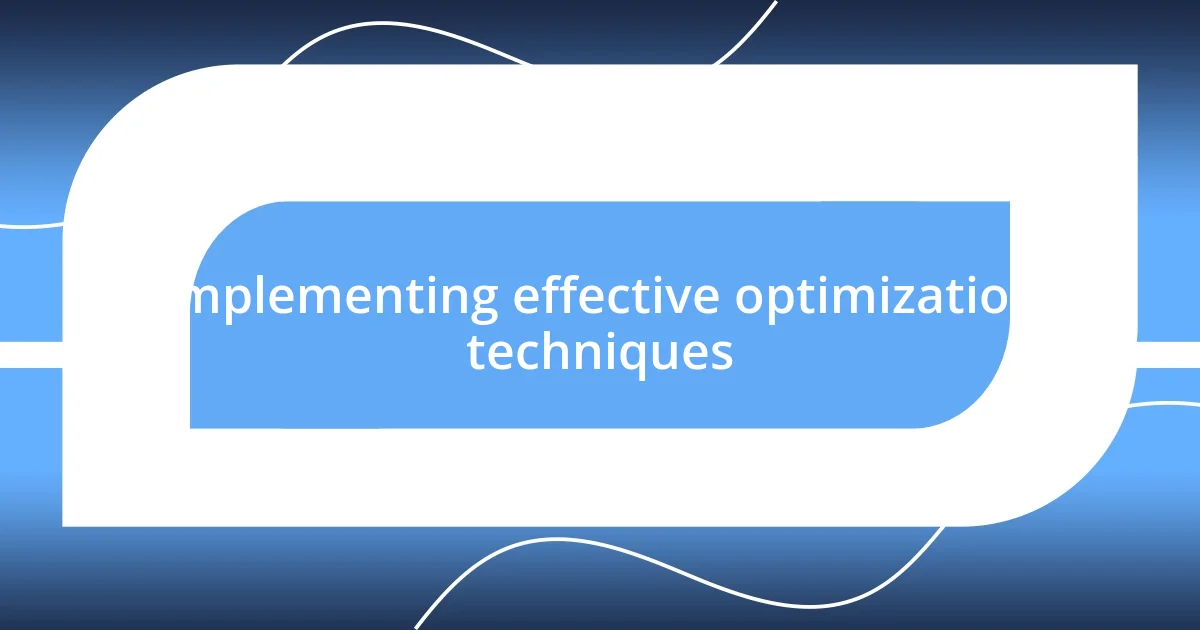
Implementing effective optimization techniques
Implementing effective optimization techniques requires a combination of strategy and practical steps. One technique that really moved the needle for my website was image optimization. I used to underestimate this aspect, but once I compressed images without sacrificing quality, I noticed my loading times cut down significantly. Have you ever experienced the frustration of waiting for images to appear? It pains me to think about how many users may have left my site during those lagging moments.
Another powerful approach I adopted was minimizing HTTP requests. Each element on a webpage, like scripts and stylesheets, can slow down the loading time. By consolidating files and using CSS sprites for images, I streamlined the loading process. I still remember the ecstatic feeling I got when I saw my performance score improve after making these changes; it was like giving my website a much-needed breath of fresh air.
Additionally, utilizing browser caching has been a game-changer. When I first learned about caching, I realized how much faster returning visitors could access my site. I can still recall the satisfaction when I implemented it; my page speed metrics reflected those improvements! Have you considered how this might impact the user experience on your site? Nothing beats the feeling of knowing that users are interacting with a website that feels instantly responsive and efficient.
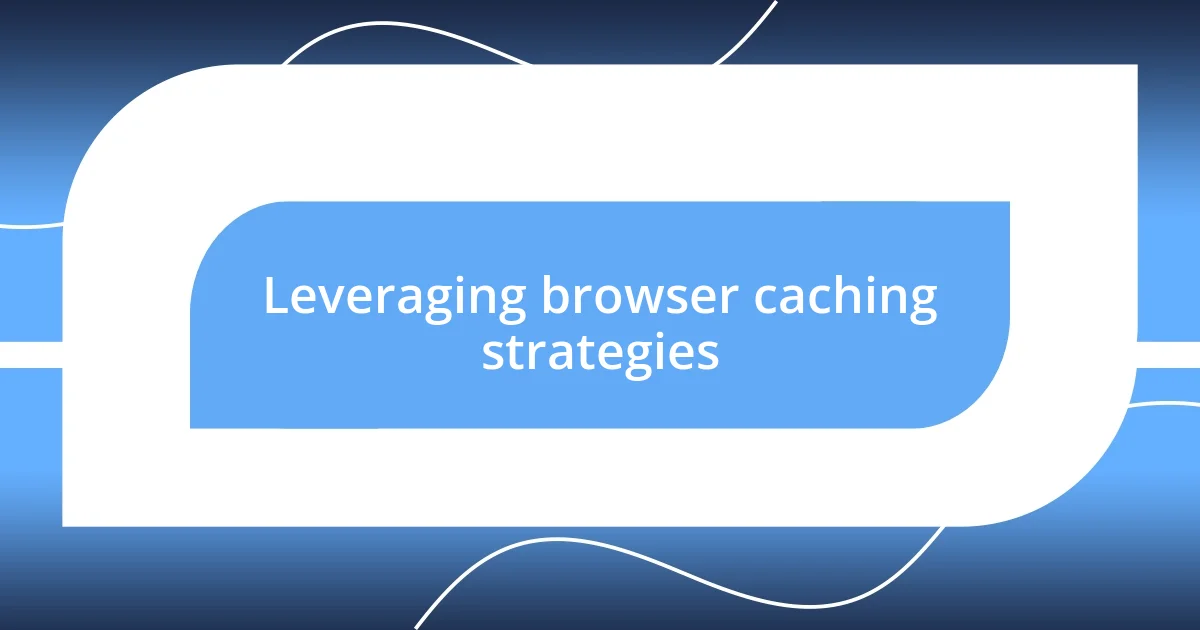
Leveraging browser caching strategies
When I first dove into browser caching, I had a light bulb moment about how it could enhance my site’s speed exponentially. By storing certain elements of my site, like images and scripts, in a visitor’s browser, I noticed that returning users loaded my pages much faster. It was fascinating to see how this simple strategy made my website feel much more efficient and user-friendly. Have you ever gone back to a site and wondered why it loaded so quickly? That’s the magic of caching in action!
One specific change I made was to adjust my caching settings through my content management system. Initially, the default settings were underwhelming; pages were still loading too slow for my liking. Once I increased cache expiration times, it felt like my site transformed into a speed machine. I remember feeling a rush of excitement when I realized that even my repeat visitors could now navigate effortlessly, making me feel proud of the user experience I was providing.
It’s worth noting that while implementing caching, I learned the importance of periodically clearing the cache, especially when I made updates. It was a practical lesson! I chuckled at myself for forgetting this step a few times and then noticing outdated information on my site. Have you faced similar hiccups? Balancing between optimization and keeping content fresh can be tricky, but the effort pays off in creating a swift, smooth experience for visitors.
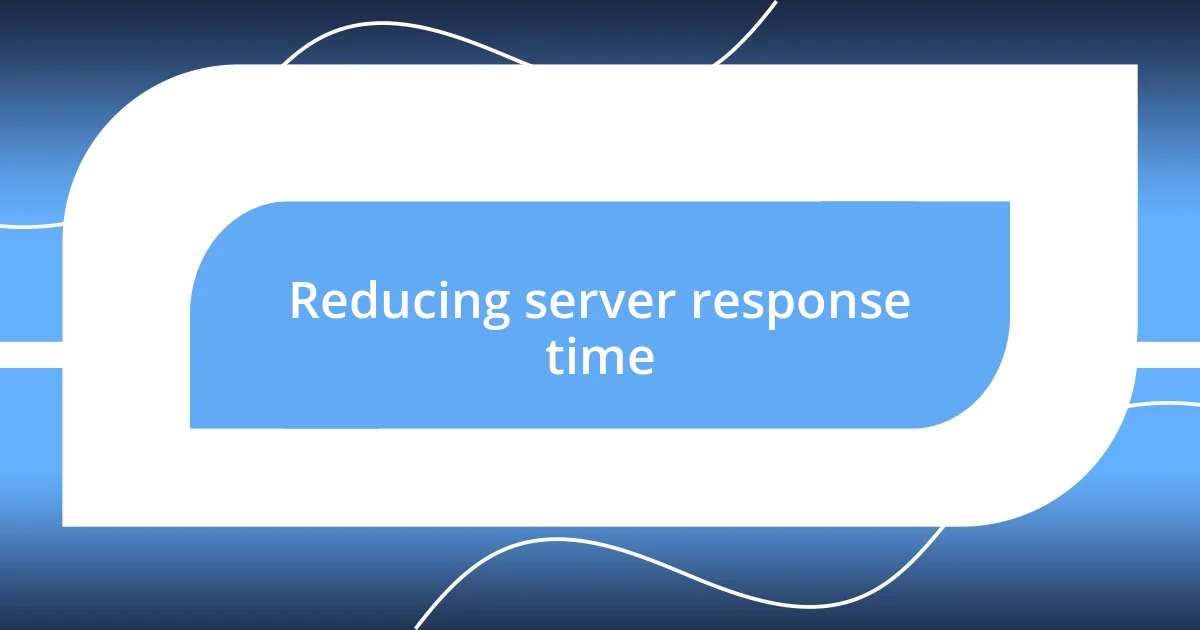
Reducing server response time
Reducing server response time was an eye-opening experience for me. I learned that the time it takes for my server to process requests can significantly impact overall page speed. When I finally got around to optimizing my database queries, I was stunned by how even small adjustments could lead to noticeable improvements. Have you ever waited on a website only to find that the response time felt endless? It’s frustrating, and I wanted to ensure my users never felt that way.
One of the changes that had a profound effect was moving to a more efficient hosting solution. I can vividly remember my skepticism when I heard it could make a difference. However, after switching from shared hosting to a dedicated server, it felt like launching my site into a new dimension of speed! I’ve never looked back since that transition; the transformation in responsiveness made me feel like I had finally taken the shackles off my website.
I also delved into reducing the server load by optimizing my server settings. I remember my bewilderment when I realized how something as simple as tweaking server configurations could lead to such significant results. This journey has taught me that server response time is a vital piece of the speed puzzle. With every improvement, I not only enhanced the user experience but also felt a growing pride in the efficiency of my site. Have you taken the time to review your server settings? You might be surprised by the benefits you could unlock!
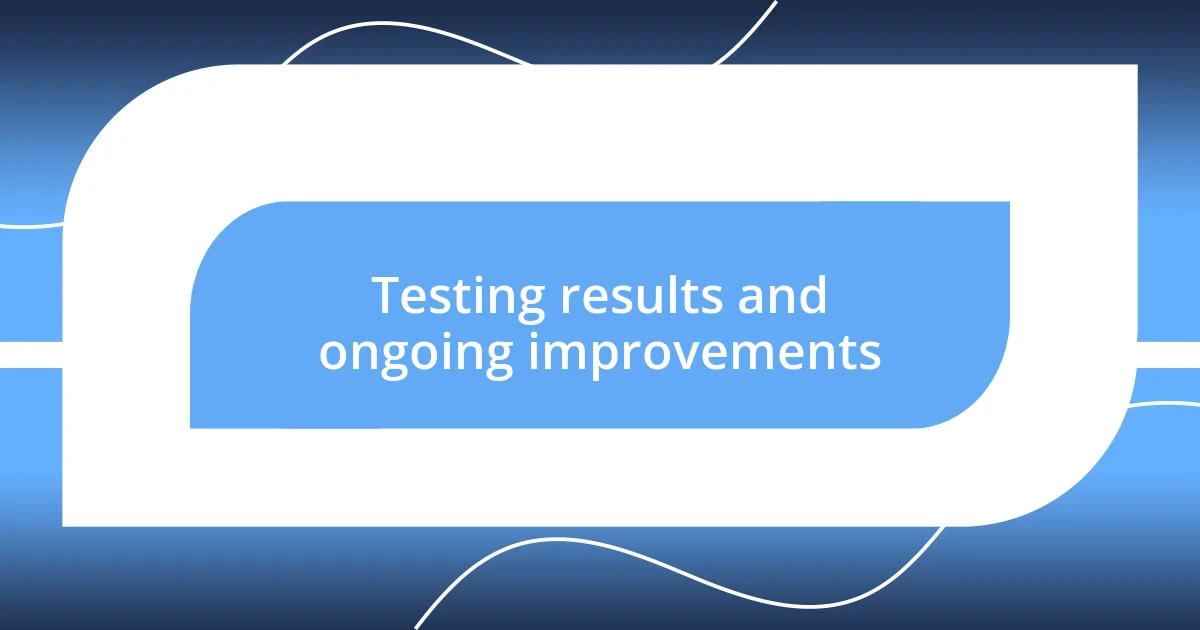
Testing results and ongoing improvements
After implementing changes, I decided to run a series of tests to evaluate the impact on my page speed. To my surprise, I saw an improvement of nearly 30% in load times. Watching the numbers shift brought a genuine smile to my face—there’s something incredibly satisfying about seeing your hard work validated. Have you ever experienced that rush when your efforts pay off in tangible results?
While I celebrated these initial wins, I knew this was just the beginning. I’ve made it a habit to continuously monitor site performance with tools like Google PageSpeed Insights. Each report is like a new puzzle to solve, guiding me to further optimizations. I remember the moment I realized how small changes, such as image compression and script minification, could lead to significant gains. It’s like discovering hidden treasures within your own site!
As I continue tweaking and optimizing, I remain aware that improvements can be fleeting. A recent update to my site inadvertently slowed things down, a humbling reminder that the digital landscape is ever-changing. This process has taught me that staying proactive is key. How do you keep pace with ongoing improvements? As I rekindle that excitement for what’s next, I am reminded that every tweak can lead to a better experience for my users, and that’s a journey worth taking.












